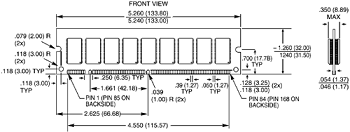SDRAM
SDRAM is short for synchronous DRAM, a type of DRAM that runs in synchronization with the memory bus. SDRAM delivers information in very high-speed bursts using a high-speed, clocked interface. SDRAM removes most of the latency involved in asynchronous DRAM because the signals are already in synchronization with the motherboard clock.
Like EDO RAM, your chipset must support this type of memory for it to be usable in your system. Starting in 1997 with the 430VX and 430TX, most of Intel's chipsets began to support industry-standard SDRAM, making it the most popular type of memory for new systems through 2000 and even into 2001.
SDRAM performance is dramatically improved over that of FPM or EDO RAM. Because SDRAM is still a type of DRAM, the initial latency is the same, but overall cycle times are much faster than with FPM or EDO.
SDRAM timing for a burst access would be 5-1-1-1, meaning that four memory reads would complete in only eight system bus cycles, compared to eleven cycles for EDO and fourteen cycles for FPM. This makes SDRAM almost 20% faster than EDO.
Besides being capable of working in fewer cycles, SDRAM is also capable of supporting up to 133MHz (7.5ns) system bus cycling. As such, most new PC systems sold from 1998 to 2000 have included SDRAM memory.
SDRAM is sold in DIMM form and is often rated by megahertz speed rather than nanosecond cycling time, which was confusing during the change from FPM and EDO DRAM. Figure below shows the physical characteristics of DIMMs.

To meet the stringent timing demands of its chipsets, Intel created specifications for SDRAM called PC66, PC100, and PC133. To meet the PC100 specification, 8ns chips usually are required.
Normally, you would think 10ns would be considered the proper rating for 100MHz operation, but the PC100 specification calls for faster memory to ensure all timing parameters are met. In May 1999, the Joint Electron Device Engineering Council (JEDEC) created a specification called PC133.
They achieved this 33MHz speed increase by taking the PC100 specification and tightening up the timing and capacitance parameters. The faster PC133 quickly caught on as the most popular version of SDRAM for any systems running a 133MHz processor bus.
The original chips used in PC133 modules were rated for exactly 7.5ns or 133MHz; later ones were rated at 7.0ns or 143MHz. These faster chips were still used on PC133 modules, but they allowed for improvements in column address strobe latency (abbreviated as CAS or CL), which somewhat improves overall memory cycling time.
Note that several module manufacturers sell modules they claim are "PC150" or "PC166" even though those speeds do not exist as official JEDEC or Intel standards and no chipsets or processors officially support these speeds.
Normally, these modules actually use hand-picked 7.5ns (133MHz) or 7.0ns (143MHz) rated chips that can run overclocked at 150MHz or 166MHz speeds. In essence, PC150 or PC166 memory would more accurately be called PC133 memory that has been tested to run at overclocked speeds not supported by the original chip manufacturer.
This specially selected overclockable memory is sold at a premium to enthusiasts who want to overclock their motherboard chipsets, thereby increasing the speed of the processor and memory bus. Table 6.7 shows the standard SDRAM module types and resulting bandwidths.